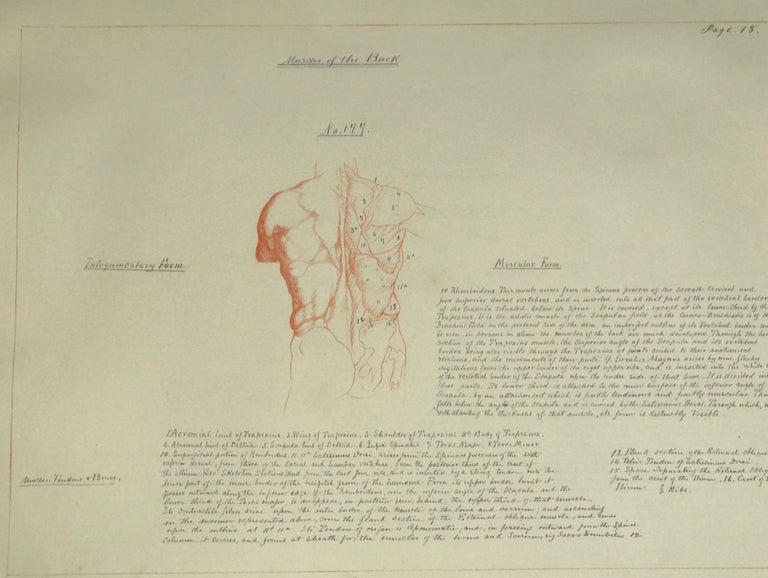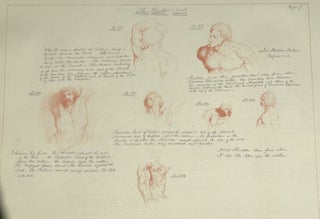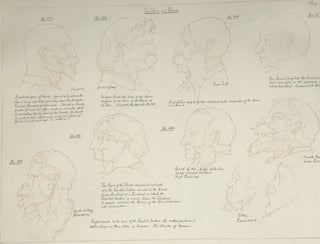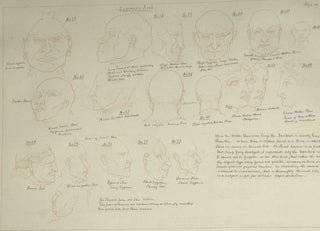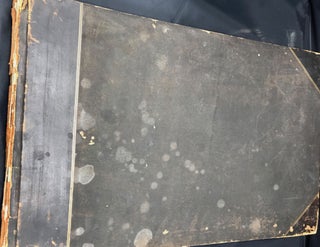ARTIST'S ANATOMICAL DRAWING BOOK, ILLUSTRATED WITH NEARLY 400 ORIGINAL SKETCHES, AND DETAILED NOTES ON CHARACTERISTICS OF MUSCLE STRUCTURE AND ANATOMY. A PRELIMINARY FOR RIMMER'S PUBLISHED WORK, "ART ANATOMY."
nd [pre-1877]. Oblong folio, 14 x 21.5 in. [1]- 21; 1-28 pp., rectos only. A total of 49 leaves of plates tabbed in, approx. 400 accomplished original sketches and drawings in red pencil, several to a page, some in outline, some more elegantly shaded and detailed, showing the human form and its various parts. Accompanied by detailed notes, in red or purple ink, in a clear, neat hand around the drawings, in both cursive and printed handwriting. Bound in 3/4 leather and pebbled cloth. Spine perished, boards moderately scuffed and spotted, front board nearly detached, marbled endpapers. Each page of drawings and notes is enclosed in a hand-drawn red pencil border, approx. 10 x 14 in. Although William Rimmer's name does not appear, this is apparently a volume of some of his original drawings, preceding the publication of his larger work "Art Anatomy," [Boston: 1877], based on a careful comparison of the sketches.
The drawings are grouped into two sections: the first group of 21 hand-numbered pages treats the skull, face, mouth, chin, ear, neck, along with comparisons of human and animal expression. A few sporadic notes mention that some of the figures were drawn from images in the Museum of Natural History in Boston. These include a chimpanzee, "a manlike ape (Drawn from a Cast in the Museum...)," the "Head of Ourang," a sketch of a lion's skull, the skull of a California Indian, and one of an Anglo-American. There are also a handful of drawings of "Negro" heads, including one "drawn from life." The drawings depict men, women and children, and pose the question: "What is the form of the head seen from above- below- from the side? What parts come into view as the Head is placed in different positions?" The author/artist also notes that "no intelligent idea of the Head can be formed until the Student has acquired a th[o]rougher knowledge of the Planes of the Face." A group of some 15 sketches of the zygomatic arch includes the remark that "[t]he jaws of Women are seldom strong or strongly marked. Men gesticulate less than Woman." Occasionally the author of these notes includes questions, ie: "Suppositional: The Ear is an element of proportion only. When the Ears are coarse the Hands and Feet are coarse. When the Ears are well made the Hands and Feet are well made."
The second group of 28 hand-numbered pages includes sketches of the rest of the human body, the skeleton, sternum, clavicle, hand, wrist, foot, knee, ankle, shoulder, etc. showing bones and muscle structure in meticulous and nuanced detail, and with extensive notes. Part of the commentary on the page delineating the hand: “An intellectual sense of equilibrium united to the instinctive sense in persons of taste- gives grace and precision to the motions of the Body…. Narrow shoulders and Pelvis and large Hands and Feet are inversions of the principles of mechanical uses or equilibrium in the Human Body- The motions of persons so made can never be other than awkward and inexact when put to extreme trial with one of opposite form. To discover this by contrast is the artist’s endowment, whether the executive power accompanies it or not.” Also: "The Hands of Women are more flexible than the Hands of Men; narrower in proportion to their length; of finer proportions in the Animal scale and capable of greater exactness in their use.” One sketch of the shoulder joint in torque depicts a figure resembling Christ on the cross, with his arms stretched upward, and the caption: "Extension by force.... the Pectoral muscle nearly vertical. The Ribs extended." The author/artist [Rimmer, whose name does not appear on these sketches] remarks that in drawing one should "Avoid skeletal outlines- make no display of technical anatomy. A work of art should be something more than the solution of a problem in science." Item #64450
William Rimmer was born in Liverpool, England and moved with his family first to Canada in 1819 and then to Boston by about 1825. He studied medicine under Dr. Abel Kingman of Brockton, Massachusetts, reading extensively in his library and observing dissections at Massachusetts Medical College. He practiced medicine for a number of years before turning to teaching at art schools, especially anatomical drawing "modified for artistic purposes." [see: Dorinda Evans' book "William Rimmer: Champion of Imagination in American Art," (Open Book Publishers: 2022)]. In ca.1863 he gave a series of lectures at the Lowell Institute on the subject of Art Anatomy. He taught at schools in Boston, Worcester, New Haven, Providence, and New York, including at the School of Design for Women at Cooper Union. His obituary, published in the Boston Evening Transcript on Aug. 21, 1879 notes: "But perhaps the most valuable work of his life is his great book on Art Anatomy, published by Little, Brown & Co. in 1877, containing fac-simile reproductions of the doctor's original drawings. Casual observers of this work have charge him with copying the antique statues, but the writer, whose fortune it was to be with him during most of the time of its preparation, knows that not a single copy exists in the book. The drawing was done mostly during a vacation in the country, and most of the drawings were made by the doctor while seated upon the grass under a tree, without model and without reference to anything whatever."
The National Gallery of Art's brief biography of Rimmer mentions he was primarily self-taught: "Although an amateur in many respects, he was the most gifted sculptor of his generation in America, a painter of compelling and evocative images, a powerful and imaginative draughtsman, and an important teacher." His influence can be seen on the works of John LaFarge and Daniel Chester French, and his admirers include Gutzon Borglum and Leonard Baskin. "Only about two-thirds of Rimmer's approximately 600 known works have been traced, and the quality of most of those that survive is high."
Price: $12,500.00

